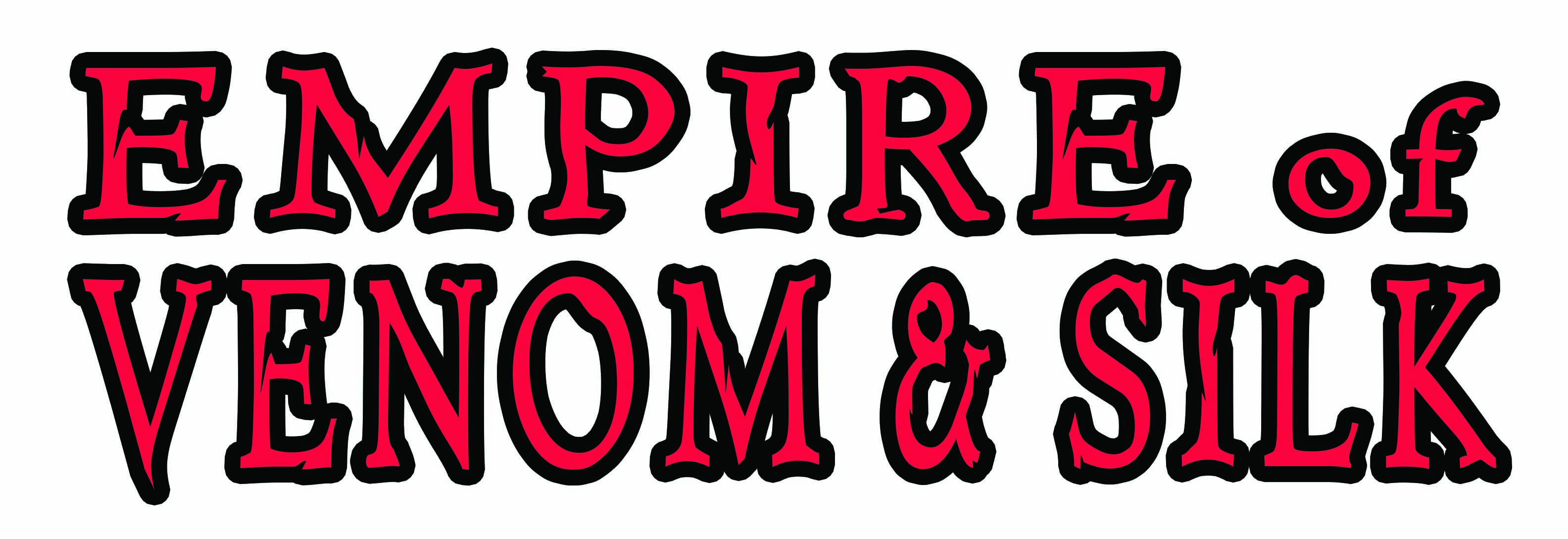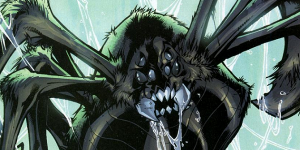In the Empire of Venom & Silk fantasy storyworld, the world has been been invaded by giant, sentient spiders. Today, thanks to the generosity of my patrons, we’re taking a look at the magic-using spiders known as “spell-spinners” and the spells they spin.
Spell-spinners use their webs to create magical effects. Specifically, they arrange their webs into intricate, arcane patterns charged with magical energy. These patterns, called “weaves,” affect the objects and creatures onto which they are cast, enchanting them or cursing them according to the spinner’s will. Spell-spinners can also spin weaves into the forms of magical objects, such as weapons or armor, for themselves or others to use.
In order to perform these feats of magic, spell-spinners must ingest Milk of the Earth. A little Milk goes a long way, but without it, spinners must draw on their own spiritual reserves in in order to create weaves. This is exhausting. And spinners who spend too much of their energy casting spells can weaken, sicken, and even die.
Under ideal conditions, spider magic is powerful, but slow. Weaves require time and concentration to cast properly. If a spell-spinner is interrupted mid-weave, it may not be able to pick up where it left off, but need to start over again from the beginning. Most weaves take at least 30 minutes to form, but if the spinner takes longer, the spell is more effective.
Spell-spinners can cast magic quickly (such as in the middle of a battle), but their weaves are not nearly so effective. They can get their casting time down to a minute or less, but the spells they cast are mere shadows of their more time-consuming counterparts. This is why human rebels prefer to ambush spinners far from their nests; an entrenched spinner is nearly unbeatable, but one that’s firing webs without time to think or prepare is little better than any other weaver.
Weaves don’t last forever. A weave’s duration depends on many factors, the most important of which are how long the spinner took to craft it, and how much Milk of the Earth went into its creation. Spinners can reinforce existing weaves at a fraction of the time and Milk the original cost to make.
Weaves are divided into two broad groups: enchantments and creations. Enchantments are those that affect the person or object onto which they are woven. Creations are objects created from the spinners’ magical webbing and infused with mystic energy. Below are examples of the weaves of both types.
Enchantments
Animate: By casting this weave on an object, the spinner can give it a crude semblance of life. While such objects have no true intelligence, spinners can, with enough effort, give them a bit of autonomy.
Change Size: Depending on the how the weave is implemented, it can cause its target to grow or shrink many times over.
Degrade: This weave causes its target to weaken or even crumble away. Spell-spinners have used this to create holes through walls, ending their sieges on human cities.
Enshroud: This weave makes its target invisible.
Enlighten: Often used to illuminate the gloomy corridors of the spiders’ castles, this weave makes its target give off a light of a color and intensity chosen by its caster.
Ensnare: This weave forms a pattern that entraps those who look at it. All but the strongest-willed humans, upon seen the weave, want nothing more than to stop what they’re doing and look at the weave.
Harden: This weave strengthens its subject, making it sturdier and more resistant to damage. It’s used on structures to help build up walls, and on creatures to give them a form of magical “armor” in combat.
Manipulate: Objects with this weave on them can be lifted, rotated, and generally manipulated with the mind of the caster or his designated proxy. Spinners use this weave to compensate for their lack of hands or fine motor control.
Mindspeak: When a spinner casts this weave onto a human, that human can telepathically communicate with any spider in line of sight.
Sense: A spinner can turn the target of this weave into a remote sensor, allowing it to telepathically see and hear activity near the enchanted object.
Creations
Cloth: Weave cloth is imbued with a long-lasting enchantment of the spinner’s choice: armor, protection from the elements, the ability to fly… the list is endless, but the more elaborate the charm, the longer the cloth takes to make, and the more Milk it requires to produce.
Weapons: Spell-spinner web can harden, creating a substance that’s unbreakable as iron but light as balsa wood. Weapons made of such web are effective on their own, but are often imbued with a weave as well, such that they inflict extra damage, set the target on fire, or have some other battlefield ability.
Knowledge Scrolls: Spinners can imprint their knowledge on woven silk scrolls. When other spiders (or specially-skilled and/or gifted humans) see the scrolls, the weaves on them impart the spinners’ knowledge. It is a form of writing, but so condensed and specific, it goes beyond the normal into the supernatural.
Barriers: While any web-weaving spider can create a wall of web, spell-spinners create walls imbued with magical powers. A common version of this weave has the ability to drain the life-force of any living creatures who get stuck to its strands.
This post was made possible through the support of the heroic patrons of my Patreon page. If you’re not a patron yet, I’d encourage you to swing by the page and see what we’re up to.


